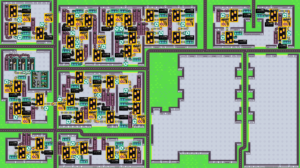Factory Idle
 It’s one of those times again when all other gameplay is preempted by something new on the Internet. Factory Idle is an automated factory simulator along the lines of Infinifactory, but it’s presented as an idling game. A closely related genre to clickers, idlers are games where resources automatically increase over time, and the player spends them on upgrades to make them increase faster. Usually they’re very abstract: you click a hyperlink to buy a factory, say, and the number by the word “factories” increases by one, as does the rate at which you produce whatever the product of the factories is. Factory Idle adds a layer of physical constraint between the raw numbers and their effects. You have to place the variously-sized components of your factories onto a grid, with conveyor belts connecting them.
It’s one of those times again when all other gameplay is preempted by something new on the Internet. Factory Idle is an automated factory simulator along the lines of Infinifactory, but it’s presented as an idling game. A closely related genre to clickers, idlers are games where resources automatically increase over time, and the player spends them on upgrades to make them increase faster. Usually they’re very abstract: you click a hyperlink to buy a factory, say, and the number by the word “factories” increases by one, as does the rate at which you produce whatever the product of the factories is. Factory Idle adds a layer of physical constraint between the raw numbers and their effects. You have to place the variously-sized components of your factories onto a grid, with conveyor belts connecting them.
Optimizing the use of rooms with different dimensions is an enjoyable challenge, and one that has to be redone frequently, as upgrades change the optimal proportion of components. For example, when I first built a plastic maker, I had to give it the full output from two oil buyers, two gas buyers, and two coal buyers to get the most use out of it — which you definitely want to do, because the plastic maker costs the same amount of money to run whether it’s producing optimally or not. Then I upgraded the plastic makers so that they were twice as productive, and thus needed twice the number of inputs hooked up to them. So I wiped all my rooms one by one to lay them out differently.
You can spend a lot of time fiddling with your layouts in this game, tweaking them to get just a little more free space that you can jam another component into. And for that reason, I’ve seen the game praised by people who don’t normally like idlers. You don’t have to wait for it! There’s always something to do! (Until there isn’t.) But the same words mean that it kind of fails as an idler. I’ve played other idling games before, and let me tell you, you don’t play them the same way you play other games. Idlers exist to be played while you’re doing something else. You’re at work, or your’e writing a blog post, or something of the sort that requires attention and keeps you sitting in front of a computer, but the mind requires occasional distraction. So you have something you can check on every so often. You can use Twitter or Facebook for this purpose, or you can use a game. And when you’ve checked on your idler, and seen that you can finally afford that one upgrade you’ve been waiting on, and clicked to buy it, you can go back to what you were doing before. Factory Idle is frequently too involved for that. It seems to be slowing down as things get more advanced, as idlers and clickers often do. The moments when I redesign everything aren’t as frequent as they were at the beginning. But at the same time, my factory is a lot larger than it was back then, so each major redesign takes more time and attention, more suited to lunch breaks than microbreaks.
 Comments(1)
Comments(1)
It looks like it shares a lot of similarities with Factorio, in terms of the pleasure of designing a conveyor belt layout that is efficient even when the assumptions change. Factorio isn’t an idle game but it does have a certain amount of waiting for automated processes to complete.